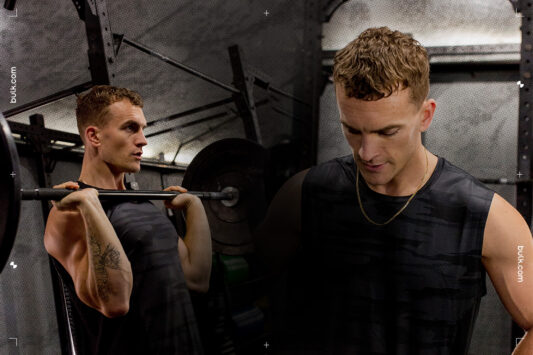The first few gym visits can be daunting. It feels like everyone knows what they’re doing except you. But that’s not always the case. From skipping the warm-up to comparing yourself with others, we’re all guilty of a gym faux pas. Ready to beat the bad habits? Here are thirteen common gym mistakes.
1. Failing to warm up properly
This doesn’t have to involve fifteen minutes of stretching. For shoulder days, doing some rotators with a small plate will keep your shoulders healthy. If you have one, a resistance band is great too. There’s also the common dynamic stretches you can do to get your joints moving such as doing circles with your arms, and crossing your shoulders. For legs, lunges and ‘over-the-gates’ are excellent for loosening up. Even if you’re doing an upper body session, it’s a good idea to warm-up your lower body too. It helps avoid cramp and tightness when you need them for leg drive.
For bigger, more demanding lifts like the bench press or deadlift, it’s wise to have multiple warm-up sets by performing the movement at lighter weights. These are important not just for injury, but to prepare your body and CNS for the heaviest sets. If you’re training strength, try and be as explosive as you would if the weight was maximal. This really tunes up your muscles for intense activation.
2. Not training with proper form
Proper form and technique are vital for a number of reasons. Firstly, training movements with bad form can cause injuries, with unwanted stress being put on ligaments and joints.
Form is also important for gaining the best results. Yes, you may get newbie gains from performing exercises at 50-60% efficiency, but if you increase this to 90-100%, just imagine the results.
The biggest barrier to good form is lifting weights that are too heavy, causing your control and technique to suffer. So when you perform your movements, think about the tempo (speed) and contraction as much as possible. As a general rule, eccentric portions of movements (eg. lowering the barbell on bench press) should be at a lesser tempo. Think slow. Think controlled.
3. Lifting too heavy
Sometimes known as ‘ego lifting’, lifting too heavy is a common gym mistake. As mentioned earlier, lifting too heavy is one of the biggest barriers to form. If you lift too heavy, you can’t control the weight properly meaning your technique suffers. Not only does this affect your gains, it increases your risk of injury too.
Lifting too heavy also prevents you from getting proper volume in. If your goal is muscle growth or hypertrophy, you want to have sets with higher reps – that’s 8-12 and above. If you lift too heavy, you won’t manage many without your form suffering.
That said, you need to be careful that you don’t lift too light either. You want to be in the sweet spot for the movements to be challenging while maintaining the ability to execute them with good form.
4. Not using progressive overload
Progressive overload is a vital aspect of resistance training. It involves gradually increasing the demands placed on your muscles to continue progress over time.
When you first start training, it’s easy to get into a routine of lifting at the same intensity and volume for too long, meaning the gains plateau. It’s important to keep the workouts challenging in order for your muscles to adapt.
The easiest way to implement progressive overload is via intensity (weight), though it can also be done via volume, rest times and tempo. Here’s an example of progressive overload for bench press
Let’s say you currently bench press 70kg for 4 sets of 8 reps. To apply progressive overload, you could:
- Increase the intensity (weight): add 2.5kg to each side of the barbell and complete 4 sets of 8 reps with 75kg. When this gets comfortable (after one or two weeks), add another 2.5kg on each side.
- Increase the volume (reps): keep the weight at 70kg and try to complete 4 sets of 10 reps instead of 8 reps. Once you can do this easily for over 12 reps, it is time to increase the weight.
By gradually increasing the demands placed on your muscles over time, you continue to make progress in your mass and strength gains.
5. Training to failure or maxing out every set
Although training to failure can be a beneficial aspect of bodybuilding, doing it for every set loses its efficiency. Save your AMRAP (as many reps as possible) sets for the final one of each exercise.
This also applies to strength training. Be strict on yourself and save your CNS. Only max out when you’re going for a PB, otherwise your body won’t have time to recover between sessions. Stick to an RPE (rate of perceived exertion) of around 8/10. You should rarely be going to 10/10.
6. Skipping legs
Including leg exercises in your workout routine can help improve your posture and athletic performance, reduce injury risk and improve your overall fitness and health.
Skipping leg day means you’re missing out on two of the best movements for building mass and increasing general performance: squat and deadlift. They work the major muscle groups of the body.
You should be doing these lifts if your goal is to get stronger, build muscle and maintain a balanced physique. That’s why most training programs feature these exercises or their variations.
7. Being fasted for no reason
There’s a myth that doing fasted cardio burns more fat. Studies indicate that body composition changes associated with aerobic exercise in conjunction with a hypocaloric diet are similar, regardless of whether or not an individual is fasted prior to training. Hence, those seeking to lose body fat can choose to train either before or after eating based on preference [1].
We respond to a general caloric deficit, meaning what matters most is overall calorie intake versus output. Fat burning must be considered over the course of days to meaningfully assess its impact on body composition.
For some people, training on an empty stomach may hinder performance because there just isn’t enough fuel. Consuming before each workout would then enable a more productive session.
8. Avoiding compound movements
Compound movements are exercises that work multiple muscle groups at once. Examples include exercises like bench press, deadlift and squats. They should be a staple of every gym programme. Every time you step into the gym for resistance training, you want to get at least one or two of them in there.
Performing compound movements at the beginning of your workout helps warm the rest of your body up. Then can move onto your isolation movements (things like lateral raises and bicep curls). If you have a solid bench press, shoulder press and deadlift, this creates an amazing foundation for your physique to rest upon.
9. Copying others in the gym
This is an easy trap to fall into. When you first start training, it can be quite intimidating. Everyone seems to know what they’re doing. But this isn’t always the case.
Everyone has their own goals. follow an expert or registered PT. Trust their form and advice, not people in the gym. Jeff Nippard and Joe Delaney are great examples of credible fitness experts online.
10. Taking advice from inexperienced influencers
Just because a person online has an amazing physique or big following doesn’t always mean they have the best information on the gym. There are people online with massive platforms, without real experience coaching others or giving well-rounded, evidence-based information. And it shows.
It’s important to only take advice from those who are qualified – ones who can give you clear, science-driven information about the gym and fitness. Here’s a list of some credible creators to start you off:
11. Not having a plan
Walking into the gym without a plan is an awful feeling. With so much choice and no plan, it can be overwhelming.
Following a gym programme is the best way to prevent this, with your workout planned out days before. This can be one you create yourself or one recommended by an expert. There’s an abundance of information on gym programmes online, suited to all kinds of different goals, whether it be muscle growth, strength gain or weight loss.
12. Checking your phone too much
Many gym-goers think they need to be in the gym for hours and hours to have a good workout. This isn’t true. If you’re present in the moment, strict with your rest times and concentrate on your workout, you can achieve a lot in forty five minutes.
Checking your phone all the time is a difficult habit to get out of. Treat your workouts as an opportunity to disconnect. You’ll get more from them.
13. Comparing yourself to others
‘Comparison is the thief of joy’ Theodore Roosevelt.
Comparing yourself to others in the gym or online is counterproductive and can be damaging to your mental health. Instead, focus on your own progress and celebrate your own achievements, no matter how small they may seem. Remember, everyone has their own unique fitness journey and the most important thing is to stay committed to your goals. Make progress at your own pace. It’s you vs you. You can’t compare your own chapter one to someone else’s chapter twenty.
We believe in encouraging everyone to find their passion for exercise. For more fitness content and common gym mistakes, check out @bulk for recipes, ambassador workouts and gym tips. Join our community of fitness lovers and foodies.












